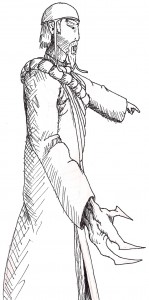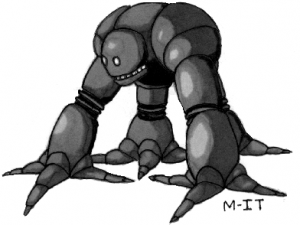Yesterday was pretty special, I GMed a game of The Artifact with two completely new situations. The first one was we used only 3rd edition rules and characters. The second was that it was just my kids playing and it turned out really cool. They’ve sat in on games and had characters but this was the first time there was no one else to coach them along with what they should be doing.
The setting, a great rift where the underground structure has collapsed for hundreds of Kilometers. The rubble has formed a valley. Several landmarks in the valley include Reshrone Rochbareeth, the great stone of the Rochbareeth, a colony of Pteranodon like animals. The cave of voices on the edge of a region that’s covered in caves of various sizes. The Great Kelrath Quarry, an area that the Kelrath used a thousand years ago to mine for materials to build their cities. The Valley of the Zah, an ancient garbage dump where bacteria are still breaking down the chemicals left over from the Kelrath and a great mat of Zah (eatable bugs) are feasting on the bacteria. Finally, the Valley of the Kerdi, a forbidden area that the Kerdi defend but no one knows why.
The two players have their characters, one a Scimrahn E-Suit pilot named Enedger and the other an I-CA scout named Kagami. They are traveling with the Dreech tribe, a group of Carriers. The tribe uses this area to rest and has several safe houses hidden in the terrain. An I-CA platoon is assigned to the Dreech to help them. While resupplying, one of the other I-CA scouts named Habibe has gone missing and our two characters are sent to go out and retrieve him.
The two head off in Habibe’s last known direction and the E-Suit picked up a small object giving off a small amount of heat. They investigate and find out it’s an I-CA microdrone that Habibe must have launched. Kagami quickly figured out that it had run out of power and crashed and was probably flying in a straight line. They could follow it’s flight path back and track him.
Finding his footsteps they followed them to the mouth of a cave. The E-Suit’s sonar could hear faint sounds in the cave. This was a great chance to use 3e’s Survival Challenges and it all went really well. Enedeger considered just letting Kagami go in alone and he would wait outside but must have gotten bored with that idea because he locked his E-Suit and followed her in. There was a pit they had to jump over, a gallery of rocks that they got lost in, an underground stream that they swam through, and then a larger pit they had to climb around. They came to a squeeze in the tunnel that they had to disassemble their large gear and squeeze through. Neither was sure about this part of the cave and they considered doubling back but the physical stress was starting to make it too hard for Kagami to keep going and the two rested for several hours.
Squeezing through the tunnel Enedger panicked and had to double back. Kagami squeezed through and came face to face with a Gunthar (1.5 meter tall dinosaur like creature). It attacked her but she avoided its attack and then took out a knife and rolled her 1/8th which allowed her to stab it under the chin where its armored skin was weak. In one stab she had taken it down and had dinner.
Here the cave opened back up to the rift valley. Enedger finally was able to push through the pinch in the cave and the two emerged only to be greeted by a warning shot and someone calling “Don’t follow me.” which Kagami figured out was Habibe.
We stopped there for the night. The kids had fun and I did too. I’m planning the next session and will post when we play again.
I found a few omissions and errors along the way and marked them for correction but otherwise the survival rules worked really solidly. It was also cool to see the fraction column rules come into play and work the way they did. The kids got real excited when they got a good roll. It was a great game all around, simple but with just enough challenge making it interesting.




 The Free RPG Blog
The Free RPG Blog